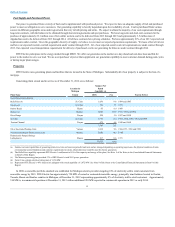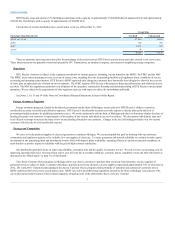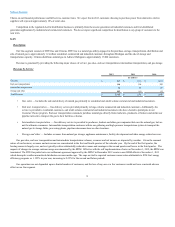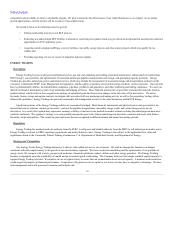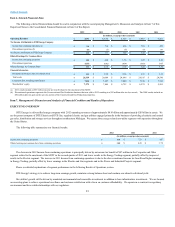DTE Energy 2012 Annual Report Download - page 18
Download and view the complete annual report
Please find page 18 of the 2012 DTE Energy annual report below. You can navigate through the pages in the report by either clicking on the pages listed below, or by using the keyword search tool below to find specific information within the annual report.
Table of Contents
See Notes 11 and 19 of the Notes to Consolidated Financial Statements in Item 8 of this Report and Management’s Discussion and Analysis in Item 7 of
this Report.
We had approximately 9,900 employees as of December 31, 2012, of which approximately 4,900 were represented by unions. There are several
bargaining units for the Company’s represented employees. The majority of represented employees are under contracts that expire in June and October 2013.
Risk Factors
There are various risks associated with the operations of DTE Energy's utility and non-utility businesses. To provide a framework to understand the
operating environment of DTE Energy, we are providing a brief explanation of the more significant risks associated with our businesses. Although we have
tried to identify and discuss key risk factors, others could emerge in the future. Each of the following risks could affect our performance.
We are subject to rate regulation. Electric and gas rates for our utilities are set by the MPSC and the FERC and cannot be changed without regulatory
authorization. We may be negatively impacted by new regulations or interpretations by the MPSC, the FERC or other regulatory bodies. Our ability to recover
costs may be impacted by the time lag between the incurrence of costs and the recovery of the costs in customers' rates. Our regulators also may decide to
disallow recovery of certain costs in customers' rates if they determine that those costs do not meet the standards for recovery under our governing laws and
regulations. Our utilities typically self-implement base rate changes six months after rate case filings in accordance with Michigan law. However, if the final
rates authorized by our regulators in the final rate order are lower than the amounts we collected during the self-implementation period, we must refund the
difference with interest. Our regulators may also disagree with our rate calculations under the various tracking and decoupling mechanisms that are intended to
mitigate the risk to our utilities of certain aspects of our business. If we cannot agree with our regulators on an appropriate reconciliation of those mechanisms,
it may impact our ability to recover certain costs through our customer rates. Our regulators may also decide to eliminate more of these mechanisms in future
rate cases, which may make it more difficult for us to recover our costs in the rates we charge customers. We cannot predict what rates an MPSC order will
adopt in future rate cases. New legislation, regulations or interpretations could change how our business operates, impact our ability to recover costs through
rates or require us to incur additional expenses.
Changes to Michigan's electric Customer Choice program could negatively impact our financial performance. The electric Customer Choice
program, as originally contemplated in Michigan, anticipated an eventual transition to a totally deregulated and competitive environment where customers
would be charged market-based rates for their electricity. The State of Michigan currently experiences a hybrid market, where the MPSC continues to regulate
electric rates for our customers, while alternative electric suppliers charge market-based rates. In addition, such regulated electric rates for certain groups of our
customers exceed the cost of service to those customers. Due to distorted pricing mechanisms during the initial implementation period of electric Customer
Choice, many commercial customers chose alternative electric suppliers. MPSC rate orders and 2008 energy legislation enacted by the State of Michigan are
phasing out the pricing disparity over five years and have placed a 10 percent cap on the total potential Customer Choice related migration. However, even with
the electric Customer Choice-related relief received in prior DTE Electric rate orders and the legislated 10 percent cap on participation in the electric Customer
Choice program, there continues to be legislative and financial risk associated with the electric Customer Choice program. Electric Customer Choice migration
is sensitive to market price and full service electric price changes.
Environmental laws and liability may be costly. We are subject to and affected by numerous environmental regulations. These regulations govern air
emissions, water quality, wastewater discharge and disposal of solid and hazardous waste. Compliance with these regulations can significantly increase
capital spending, operating expenses and plant down times and can negatively affect the affordability of the rates we charge to our customers.
Uncertainty around future environmental regulations creates difficulty planning long-term capital projects in our generation fleet and gas distribution
businesses. These laws and regulations require us to seek a variety of environmental licenses, permits, inspections and other regulatory approvals. We could
be required to install expensive pollution control measures or limit or cease activities based on these regulations. Additionally, we may become a responsible
party for environmental cleanup at sites identified by a regulatory body. We cannot predict with certainty the amount and timing of future expenditures related
to environmental matters because of the difficulty of estimating clean up costs. There is also uncertainty in quantifying liabilities under environmental laws
that impose joint and several liability on potentially responsible parties.
16


